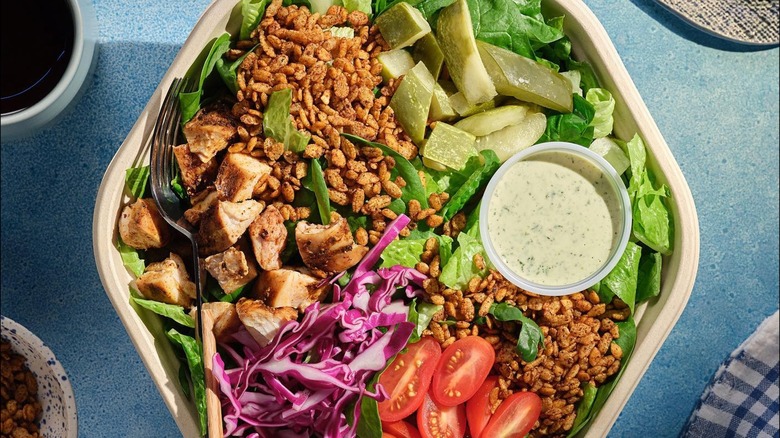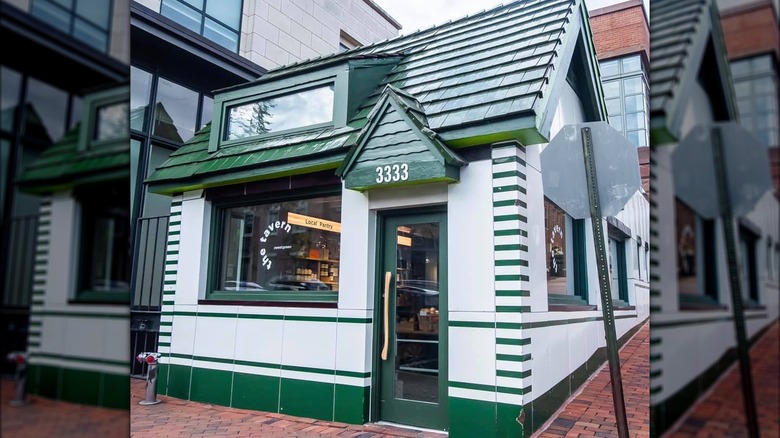The Dorm Room Origins Of Sweetgreen
College means different things to different people, and for some, it's as much about who you meet as what you learn. That was the case for Jonathan Neman, who met Nicolas Jammet and Nathaniel Ru at Georgetown University, struck up a friendship, and together, went on to found the billion-dollar company called Sweetgreen.
Was it a stroke of genius or a stroke of luck? When Neman spoke with How Brands Are Born in 2020, he suggested that it was more of the latter. "One of the best things about doing what we did when we did it, was that we knew nothing," he explained. "Hence, the naivete of not knowing what we were getting into, allowed us to take the leap and do it. I think if we knew what we knew today, we probably wouldn't take that leap."
Sweetgreen's story is a pretty brilliant example of how sometimes, you've just got to go for it. By 2024, it was reported that the company's stock was on the rise, it was eyeing more expansions into suburban markets, and it had around 225 locations. At the time of the 2020 interview, the founders were sitting comfortably with just 91 locations. Growth was happening at a staggering pace: Sweetgreen was overhauling kitchen systems to be powered largely by robots and artificial intelligence, adding menu items like steak, and making it clear it was sticking to the principles that its founders had hashed out in their Georgetown dorm rooms right at the start.
Sweetgreen's founders met randomly at college
In a conversation with How Brands Are Born, Sweetgreen CEO Jonathan Neman (pictured) spoke a bit about how he met two fellow Georgetown students and how they became co-founders of a billion-dollar restaurant empire. He said he met Nicolas Jammet on his very first day at college simply because their dorms were next door to each other. The third partner, Nathaniel Ru, happened to grab the seat in front of Neman during an Accounting 101 class. The two Los Angeles natives struck up a conversation sparked by Ru's Lakers hat, and the rest was history.
Neman says that they quickly learned that they had something important in common. "We bonded over this idea of creating a healthy place to eat that was delicious, affordable, convenient, and really stood for something," he explained. "And we also really all shared a passion for building something from scratch, and so we started writing a business plan, with a simple mission that we still have today, which was building healthier communities by connecting people to real food."
In 2019, Jammet spoke with CNBC about their inspiration, saying that it was very much built from their experiences living in a college town. There were food choices available, he said, but they struggled with finding decent meals at a price point they could afford. "(T)he coolest food... was all the least healthy. None of them made us feel that good, and we wanted to solve that problem."
Sweetgreen was founded in 2007, and it was a rocky start
Even the best ideas need capital to get off the ground, and Sweetgreen's founders reached out to hundreds of people to find investors for their idea for a restaurant that offered a line-up of healthy salads. They ended up getting 50 people to say yes, netting them $300,000 for their start-up. For comparison, opening just one of the astonishing number of McDonald's franchise restaurants in 2024 comes with projected costs of between $1.3 and $2.4 million.
Sweetgreen's founders opened the doors of their first restaurant (pictured) just three months after graduating college. It was rough going — particularly because they were the victims of a theft two days before they opened their burger-shack-turned-salad-shop. Their computer was gone, and that meant everything was gone. "All our operating manuals, all our recipes. Literally everything," Jonathan Neman told How Brands Are Born. "We stayed up for two days rebuilding everything from scratch, and while it was really painful, I actually think some of the recipes came out better."
The trio have also spoken about how they had no idea what they were doing when they opened their first restaurant. That, Neman says, helped create an environment where they see failure as a learning experience and an opportunity to grow. It worked. Within a year and a half of opening their Georgetown location, they expanded with more locations in Washington, D.C., and haven't looked back.


